Preliminary results of the "Emergency Questionnaire for University and Graduate Students" Grasping the actual situation of the University of Tokyo under the spread of the new coronavirus infection
"Emergency Questionnaire for University and Graduate Students" Results Flash Report
Grasping the actual situation of the University of Tokyo students under the spread of the new coronavirus infection
The lives of university students are undergoing major changes as Japan is in turmoil due to the novel coronavirus.
The purpose of university co-ops is to support the lives of members of the university community. What kind of changes are occurring in the university life of the University of Tokyo due to the spread of the new coronavirus infection? What kind of worries and problems are students and graduate students facing now? At the University of Tokyo Co-op, we wanted students and graduate students to grasp the actual situation of students and graduate students as soon as possible in this crisis, and in cooperation with university co-ops across the country, we conducted an "Emergency Questionnaire for University Students and Graduate Students". . We received responses from about 870 students and 225 graduate students at the University of Tokyo (as of April 29). More than 35,000 students and graduate students nationwide have cooperated with the questionnaire.
Through the questionnaire, it is necessary to clarify the future university life and themes that the university co-op should work on. We also hope that by publishing the results of the survey, society will be able to deepen understanding of university and graduate students in this situation, and that it will lead to the improvement of university life in the future.
<Note>
Reproduction without permission is prohibited. When using the data, please contact the University of Tokyo Co-op Board Office using the form below.
●The University of Tokyo Co-op https://www.utcoop.or.jp/form/
<Aggregate results>
★Undergraduate students…See the bottom of this page
★Graduate students…Please see here (updated on 6/5)
https://www.utcoop.or.jp/cgaku/news/news_detail_5590.html
<Summary of questionnaire>
Implementing Body: National Federation of University Co-operative Associations
Response method: Response to the web form (https://www.univcoop.or.jp/news_2/news_detail_1668.html)
Implementation date: April 22, 2020 to April 30, 2020 (This article analyzes the responses obtained by April 29)
Call for responses: Requests to 1st and 2nd grade classes through the co-op member mailing list, emails to registrants of the University of Tokyo co-op e-mail magazine "withnavi", publicity on SNS (Student Committee Twitter, etc.), etc.
Number of responses: 869 from University of Tokyo undergraduate students, 225 from graduate students (as of April 29). 35,542 in total nationwide)
* There is a possibility of non-student answers due to anonymity, multiple answers, and inappropriate answers.
Please see here for the nationwide survey bulletin.
https://www.univcoop.or.jp/covid19/enquete/index.html
【table of contents】
2.1 Housing type
2.2 Tuition and income
2.3 Classes and learning environment
2.4 Circle activities
2.5 Consultant and friend
2.6 Diet
2.7 Future outlook
2.8 Anxiety about student life
2.9 Free description
2. analysis
2. Preface Respondent's Grade
There were 543 responses from first-year students, accounting for 62% of the total.Together with second-year students, 79% of the responses were from first-year students.
2.1 Housing type
Graph 1As you can see, home students (people who usually go to school at home) account for about half of all grades. Among the other half of the students who live outside their homes, "I am currently at my parents' house." In other words, there are quite a few students who are returning to their hometowns, and the proportion tends to increase as the grade decreases.Currently, the percentage of students living outside their parents' home is in the 20% range for 3rd and 4th graders, but 39% for 2nd graders and 59% for 1st graders.Nearly 60% of first-year students who live outside their homes have returned to their hometowns or have not even come to Tokyo.is. On the other hand, if you flip it over 40% of out-of-home new students live in TokyoI mean the situation. As soon as you start living alone in an unfamiliar city like Tokyo, you can easily imagine that you are in such a situation and are under considerable mental stress.
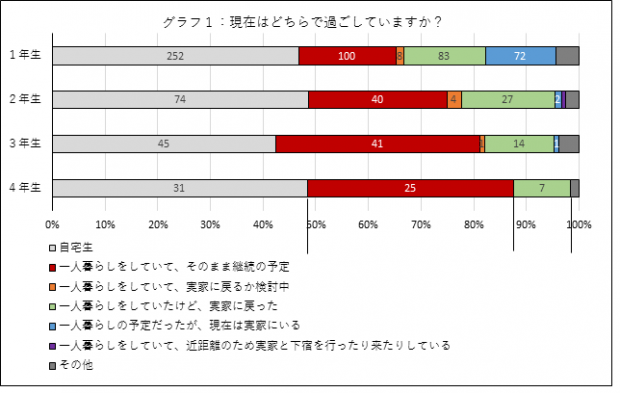
"Students living at home": those who normally commute from home "Students living outside home": those who usually commute from a boarding house other than home Those who are living at home at the moment, including those who are currently living at home. note that.
back to table of contents
2.2 Tuition and income
As shown in Table 1, more than 90% of the students answered that their guardians paid all tuition fees. on the other hand, 11% of students answered that they used one or more of tuition exemptions, scholarships, and their part-time job income to pay their tuition fees., pay attention to your financial situation.

Table 1: "How do you pay your tuition?" Column total exceeds 100% due to multiple answers.
The result of asking about "decrease in family income" that is a concern under these circumstances isTable 2is.28% of students have decreased or significantly decreased family incomeI am answering. The percentage of families whose income decreased was 27% to 30% for all attributes, with little difference by attributes such as school year or school attendance style. again, Of particular concern is the fact that 28 students who use any one or more of tuition exemptions, scholarships, or their own part-time job income for their tuition fees said that their family income would decrease.. Such respondents are considered to be in a difficult situation where their family income alone is not enough to pay their tuition fees, and their income is decreasing.

Table 2: "How much do you think your family's 'family income' could be affected by this outbreak?" There was almost no difference even if we narrowed down the school year and the form of school attendance.
again,Graph 2is the percentage of students working part-time. Naturally, The rate of part-time jobs among first-year students who have just entered school is overwhelmingly low, and does not reach 20%.. It is customary for first-year students to start looking for part-time jobs when the new semester has settled down, but in this situation, it seems that there will be a large number of first-year students who cannot start part-time jobs. Table 3I am asking about changes in income from part-time jobs.Nearly 70% of 2nd to 4th graders who are already working part-time answered that they expect their income to decrease.。
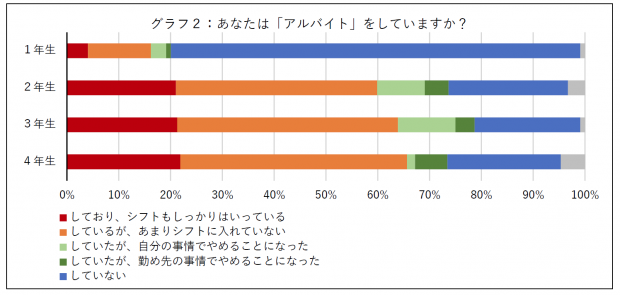

Table 3: “Please tell us about your income forecast for part-time jobs.”
Graph 3asked about future financial concerns. 47% of all respondents answered that they are “very worried” or “anxious”. In the 1st to 3rd grades, it seems that students who live outside their homes feel more anxious.
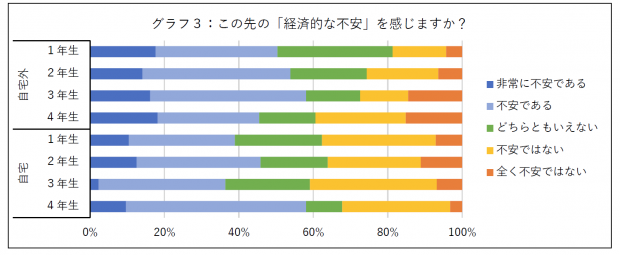
2.3 Classes and learning environment
As is well known, the University of Tokyo has moved all classes online. I asked whether the class format was “on-demand (using video teaching materials)” or “simultaneous interactive (students and teachers can take classes face-to-face in real time)”. Table 4is. There does not appear to be a significant difference in class styles between grades.

Table 4: "Please tell us about the current university classes." Row totals do not match actual student numbers due to multiple responses. Next is the result about the student's communication environment. The percentage of students who can use Wi-Fi on a fixed line with a provider contract is high among 1st and 2nd year students, accounting for the latter half of 80% of the total. A little lower than 70% for 3rd and 4th graders It is Mobile Wi-Fi was 13% of the total. Graph 4is a survey of the relationship between the communication environment in which the course is taken and the communication status. From the graph, Just because you have a provider contract doesn't mean it's stableI understand that. note that, A total of 21 people answered that they were "very interrupted and stressed."。
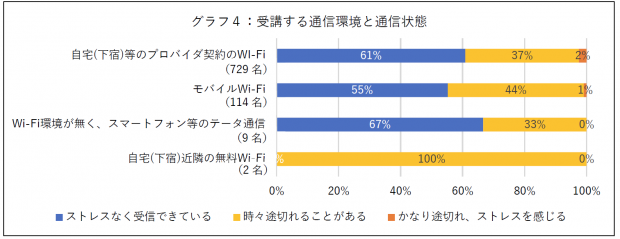
Graph 5is the result of asking about problems other than the communication environment in web classes. on almost all items Most dissatisfied among first-year studentsI understand that. The percentage of people who feel “loneliness” is not only in the first year immediately after admission, A third-year student immediately after entering the doctoral courseIt seems that there are many A prominent dissatisfaction among first-year students was "the lack of dialogue and questions from the teacher," and more students who were not living at home answered this question. again, More than 10% of students were dissatisfied with online classes because they did not have their own space, and 90% of the students who answered this were residents of their parents' homes.. It seems to be a serious problem in that it is not possible to secure a good learning environment due to restrictions in the family environment (simple solutions are difficult due to family circumstances). In addition, many first-year students complained that they did not know how to use a computer and that they did not know how to use the online class system. Existence of a group of people who are almost new to computers and are unfamiliar with them and lack supportsuggests.
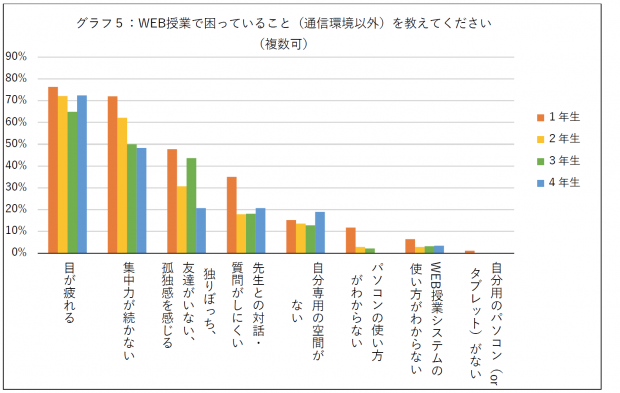
Graph 6is a question about expectations for future university classes.Many first-year students have been asking us to start face-to-face classes as soon as possible.. On the other hand, as the school year goes up, there is a tendency for more requests to continue online classes. According to another question, About one in four first and second year students calls for measures such as staggering the start of the academic year.is out.
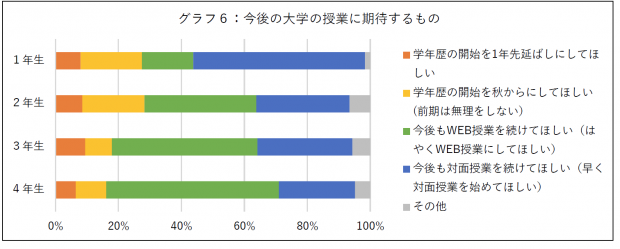
2.4 Circle activities
Almost all first-year students and about 20% of second- to fourth-year students responded to the question, "Have you considered joining a club, circle, or extracurricular activity?" Based on this question, we investigated the number of first-year students who joined clubs and the percentage of first-year students who obtained information from SNS. Graph 7is.Only 22% of first-year students have already joined the circle39% of first-year students answered, “I have decided which activities I want to participate in, but I have not yet joined.” It seems that there are many first-year students who are hesitant to join the circle because face-to-face new welcomes are restricted and it is difficult to grasp the atmosphere of the circle. again, About 90% of first-year students who answered that they have already decided which activities they want to participate in are using SNS to search for club information.I answer.
Graph 8Now, let's look at the intention to join circles by information gathering method. While an overwhelming number of first-year students use SNS to find circles, a large percentage of first-year students who do not use SNS and rely on handouts handed out at the time of admission to look for clubs have not yet decided which activities they want to participate in. I know there are many. SNS plays an important role in choosing circles and deciding where to joinI can see that.
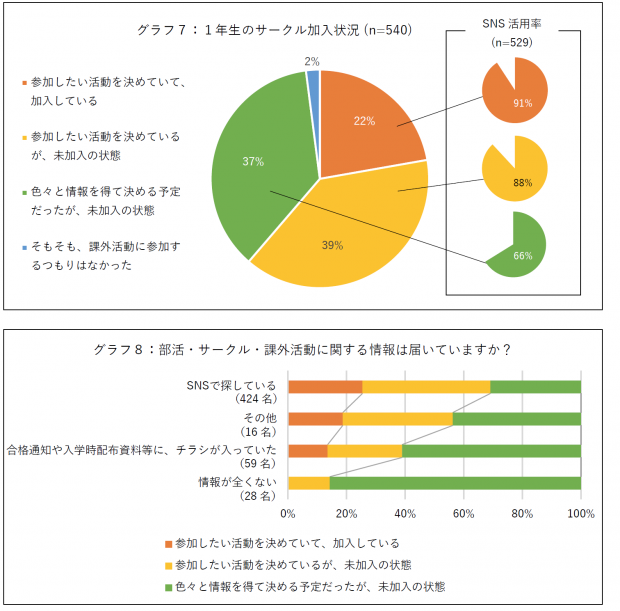
Next, I asked the 2nd to 4th graders about acquiring new members for clubs, etc.Graph 9is.70% of 2nd to 4th graders answered that they are “struggling” to recruit new members in the circle or that new members are “not at all”doing.graph 10Then, I asked about the future prospects of circles, etc.
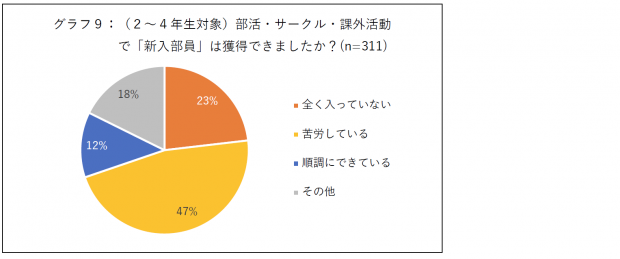
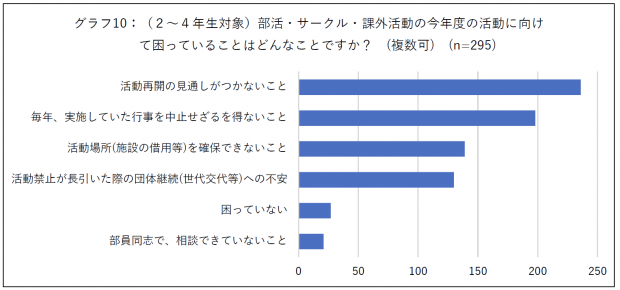
2.5 Consultant and friend
graph 11was asked if there was someone they could talk to about their problems.More than 80% of students answered that they “have” a counselor regardless of gradebutFirst-year students' "I don't have it, but I want it" stands out. In addition, when we checked the difference due to the current residence type (parents' house vs. living alone) among the 1st to 3rd graders who have a large number of samples, the number of 1st and 3rd graders who answered "I have someone to consult" It was about 6% smaller.

graph 12is a question about who you can talk to about your problems.Friends from up to high school account for 76% of the main consultations for first-year studentsIn addition, the percentage of people who answered that they were friends up until high school tended to be higher for homeschoolers.
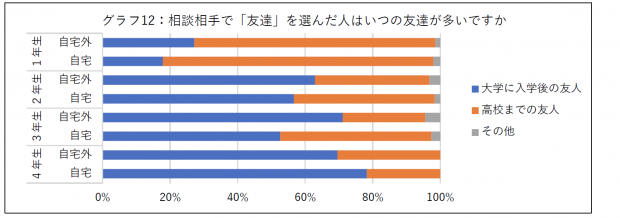
graph 13analyzes the formation of new friendships for each first-year club membership status. first The number of new friends is an unprecedented situation in which 29% of all first-year students have “0” and 34% have “less than 5”is.Circles are not decided so that new friendships are raretend to. There was no clear relationship between friendships and residential status.

2.6 Diet
We surveyed the number of meals per day and showed the percentage of people who did not eat three meals a day.graph 14is. People who currently live alone tend to skip meals compared to those living at home, Approximately 10% of first-year students living alone live on less than two meals a dayIt seems that. In addition, we analyzed the meal patterns of students who eat less than two meals a day. graph 15is.Most skip breakfast and combine it with lunchAlthough it is a pattern, there are "dinner / midnight snack (1st year female, parents' house)" "dinner only (1st year male, dormitory, 2nd year female, living alone)" "brunch only (1st year female, home)"extreme examplecan also be seen.
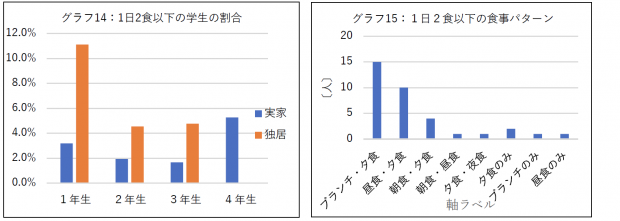
As for where they eat breakfast, lunch, and dinner, 99.5% of those living at home answered "at home", while those living alonegraph 16As shown, about 85% is at home, and about 14% is at the dormitory cafeteria.

Next, I would like to discuss the changes in the dietary environment due to the epidemic of the new coronavirus. First, we will analyze the answers of second to fourth year students who are accustomed to university life.
graph 17FromIt can be seen that there are many 2nd to 4th graders who have experienced changes in the eating environment, both living alone and living at home. In particular, 85% of students living alone answered that they had changed a lot or that they had changed a little. doing.

graph 18We asked the 2nd to 4th graders who answered that their eating environment had changed about the specific changes. Opportunities to eat out are greatly reduced, regardless of the form of residence. As for those living alone, the number of times they eat meals has decreased and their meal times are irregular. Residents have increased meal times and regularity . Is it the effect of reducing the time to go to school and being able to eat in a relatively relaxed manner?
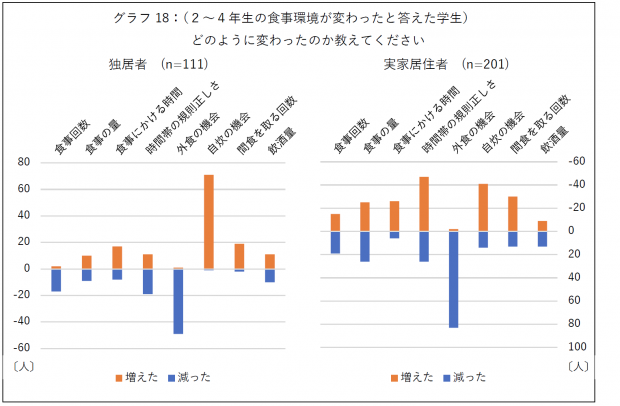
For first-year students, April is a time when the dietary environment changes significantly even in normal times when there is no COVID-19, and it is difficult to determine the extent to which the impact of COVID-19 will be included, so the graph is not presented. It is almost the same tendency as 2nd to 4th graders, The increase in self-cooking opportunities for single people and the decrease in the amount of meals are somewhat noticeable compared to senior students.。
I inquired about food costs.Graphs 19-21is. For those who live in their parents' homes, there is almost no difference in food expenses by grade, For those living alone, there is a large difference in the distribution of food expenses between the 1st graders and the 2nd to 4th graders.there is. Food expenses tend to be lower for first-year students, and food expenses for second-year students and above are divided into two.

2.7 Future outlook
graph 22is a question about future anxiety, and 70% to 80% of students feel anxiety regardless of grade.
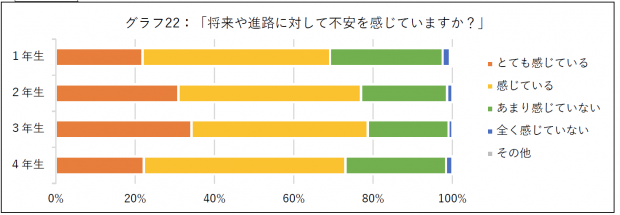
graph 23is a survey of students who answered that they "feel very" or "feel" anxious about whether or not their anxiety changed before and after the spread of COVID-19. Many 1st and 2nd year students have not yet decided on a career path, but overall, 1st to 3rd year students A higher percentage of those who are planning to find employment answered that they felt “anxiety has increased/increased due to the impact of COVID-19”It seems that. on the other hand Regarding fourth-year students, there are a considerable number of students who are planning to go on to graduate school and have increased anxiety.To do. There is no doubt that the uncertain future of job hunting and graduate school exams is increasing anxiety.
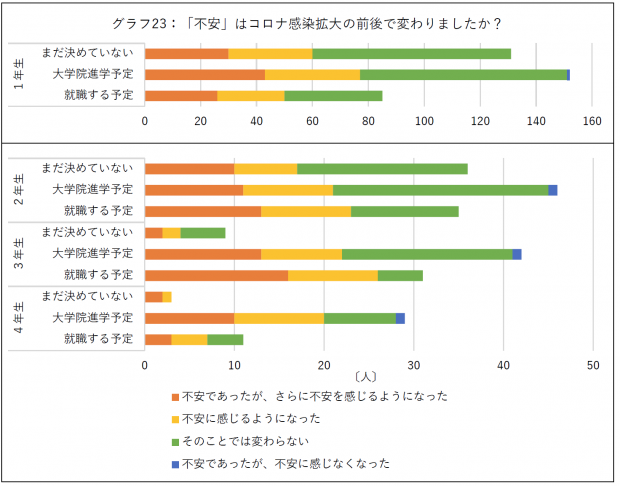
In addition, the student's outlook on the future situationgraph 24is.Nearly 60% of students expect the impact to continue in 2020 or beyondAs a result, there is no prospect of a normal resumption of classes in the A semester and a return to daily life. Many of the first-year and fourth-year students answered that they expect an early convergence, but there is also the possibility of wishful thinking due to the fact that they are just entering school and nearing graduation, respectively.
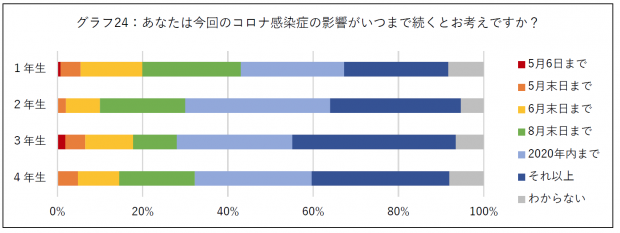
Under these circumstances, I would like to ask those who are currently looking for a job or who are aiming to go on to graduate school. I asked a question. Regarding this, ・The schedule and form of the graduate school examination are unclear. In addition, they cannot take the qualification examination required for applying for the graduate school examination. (8 cases)
・I can't do my graduation research and I'm worried about my graduation thesis. (3 cases)
・The schedule for job hunting has been postponed, and it is increasingly difficult to find a job that is already unclear. (3 cases)
・Cannot obtain information from seniors and cannot refer to seniors' stories (2 cases)
And so on.
back to table of contents
2.8 Anxiety about student life
graph 25were asked about their concerns about student life. Since there was almost no difference in response trends depending on the current residence type (parents' home vs. living alone), the normal commuting patterns (students living at home vs. living outside the home) and grades are shown. In all grades, the most anxiety is about studying at university, conducting classes, and participating in club activities.. First-year students are increasingly worried about the implementation of university events, and it seems that the fact that they were not able to hold events across the board, from new student orientation events to the May Festival, is lingering. again, Second-year students worry about obtaining qualifications and driver's licensesis seen more often than other grades.In the 3rd and 4th grade, many respondents answered that they were worried about job hunting and internships.In particular, 40% of third-year students (=almost all job seekers) are worried about job hunting. again, About 25-40% of 1st-3rd year students who study outside their home cite "financial problems"This is also important, and there is a high possibility that financial problems will arise depending on the degree of prolongation.
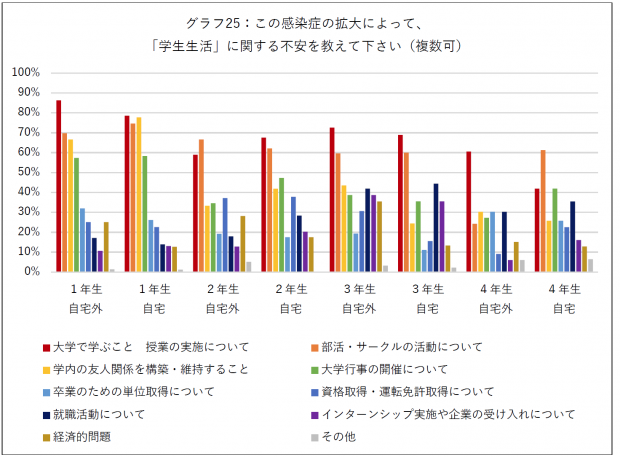
We will look at specific concerns in detail in the next section, “Free description.”
back to table of contents
2.9 Free description
For open-ended questions, "I would like to ask those who are currently looking for a job or who are aiming to go on to graduate school. What are you having trouble with due to the effects of Corona? (Number of valid responses: 38)”.Figure 1is.
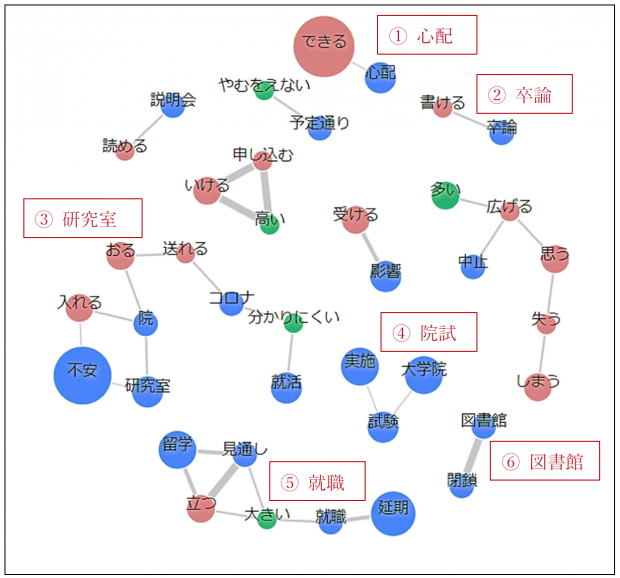
▲Figure 1: Co-occurring keyword analysis of free-form responses to questions about “problems related to job hunting and entering graduate school”
Keywords that are often taken up are roughly classified into six, as introduced in 2.7Graduation thesis/laboratory/graduate exam/employmentThere are many voices of anxiety about the uncertain outlook in each sector of again, I wish the library wasn't closedThere were many voices.We are concerned about the loss of places for learning and research, and the fact that economic power will make a difference in the purchase of books, that is, the difference in learning.Your opinion is impressive. Also," Finally, please tell us anything you think about your current university life.(Number of valid responses: 116).”Figure 2is.
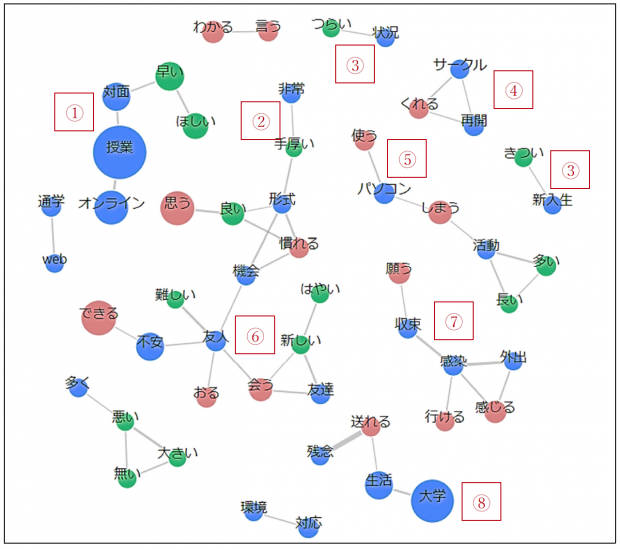
▲Figure 2: Co-occurring keyword analysis of free-form responses to questions such as “What do you think about your current university life?”
As a unity that makes sense, we will divide it into eight clusters from ① to ⑧.
① indicates that there are many opinions about online classes.Especially noticeable is the desire to resume face-to-face classes as soon as possible, almost all opinions from first gradersis. On the other hand, they said, "There are advantages to online classes, and I'm used to them," "I'm more productive online," and "I don't want to go even if face-to-face classes resume." There were several voices, mainly from fourth-year students, who wanted to continue online.。
(2) was his impression of the university's support.Some voices praise the university's support。
③ is a voice that appeals directly to the pain of the current situation. "Because of online classes, It's hard to make friends, and I don't have the chance to ask anyone who doesn't understand something in class, so I'm really worried about whether I'll be able to keep up with the class and whether I'll be able to complete my credits.. Also, being chased by assignments is very tough mentally. (1st year female, living alone)" "I don't feel like a college student at all. (Omitted) There is no sharpness in my life, I can't concentrate on my classes, and I spend my days wandering aroundSo, if this goes on for a long time, it will have a big impact on the acquisition of credits. Since the act of going to school itself was greatly related to adjusting the rhythm of life, If the current life continues, it will have a bad effect on the mindis likely.Mistakes in acquiring information and lack of understanding of class content are all self-responsibility.. I want a system that allows me to share tasks with others (first-year male, at home).”
④ is about circles. Senior students commented, "Just thinking about when the ban on club activities and face-to-face new welcome activities will be lifted, and how much new members will decrease compared to usual years makes me feel depressed" and "I wonder how many people will want to do it again even if it resumes." I'm not sure if they will think of me," Voices concerned about the continuation of activitiesIn addition, "I want to know how new students think about choosing club activities and circles, and whether they intend to decide until after the corona is over.There was also a voice saying. It may be necessary to have a place where senior students can grasp the situation of new students. In addition, from the first grade, " I'm tired of the online format and don't want to participate in the online welcome, but I'm worried that if I don't participate, I'll be left behind"Information about the circle's information session is mainly distributed only on Twitter, but there is already a group that has already closed the enrollment, and for those who do not use Twitter, I want you to stop doing that."Online fatigue and insufficient circle informationThere are also voices complaining about
(5) is mainly voices from first-year students regarding the use of computers. "As soon as I use a computer, I can't even listen to half of the lesson because of SNS and internet surfing." I can't concentrate if I can't see my surroundings, and I open another tab on my computer and feel guilty and stressed out." For new students who have just entered the school and are not accustomed to using computers for studying or using computers for long periods of time, the sudden shift to online makes it difficult to concentrate, and it seems to be a great stress.
⑥ is about building friendships.
Mainly for out-of-home studentsIt is difficult to get information such as classes because I do not meet friends or get to know seniors.」「I came to school from a rural area, so I have no friends in Tokyo., I don't have the chance to meet face-to-face with my classmates or actively talk to them, so I'm afraid I'll be a loner in college if I continue like this."relationship anxietyare being sent a lot. A student at home said, "I'm giving up on building normal friendships until the corona crisis is over." I want friendsA lot of straight shouts have been received regardless of the form of residence,You can see the harsh reality that building friendships is almost impossible。
⑦ is a lament about the spread of infectious diseases, "It is unfair that only students can not go to school", "For those who justify their own going out and go out and delay the convergence of the infection, their behavior is a nuisance to others. I want you to know that there is.” On the other hand, "It's nice to have a different method than face-to-face classes because it's stimulating. There are some good things (1st year, living alone)." )” were also voiced.
Finally, ⑧ is about university life. "I don't really feel that this is what university life is like." I was looking forward to it, so the current situation is hard." Voice of a first-year student who regrets the original university lifeare being submitted very often. Also, "I want you to at least change to September admission. If you are selfish, please delay it by a year. There is a possibility that you will graduate without the university life you imagined, and you may not be able to study abroad. There are circumstances. I understand how you feel, but I want you to make the best choice possible." , A series of events in the new semester and requests to delay the start of schoolThere was also. One first-year student described the current situation as “there is no longer anything that symbolizes university life.”
Last but not least, I would like to end by introducing a free-form comment from a respondent.
Not only university life but also social changes are taking place, and I feel great significance in the fact that various online initiatives have been institutionalized and promoted with force. However, with the uncertainty of the future unavoidable, there are many problems such as human relations that cannot be solved by going online, and there are many things that the university cannot do anything about. I hope that university co-ops will play a part in solving problems, and that only university co-ops can do it.
that's all

